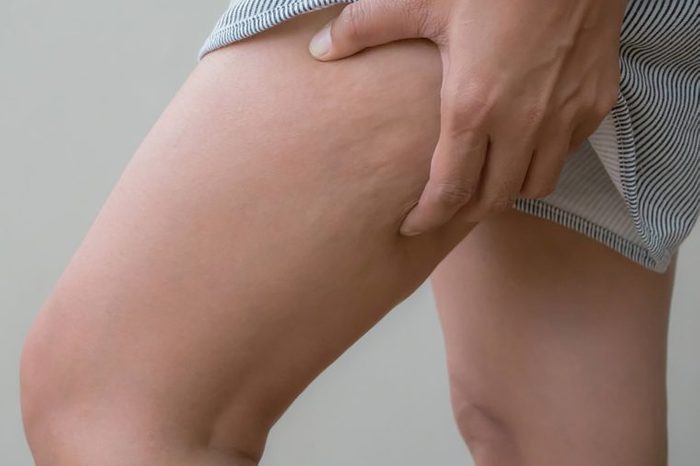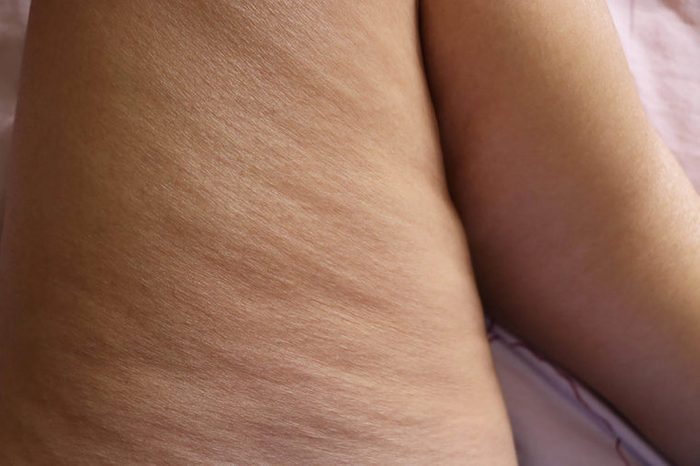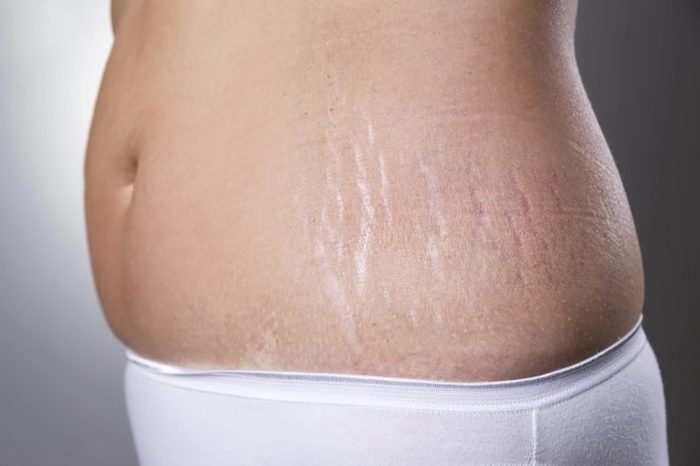
Myth: Only overweight people develop cellulite
This is totally false, says Ellen Marmur, MD, dermatologist at Marmur Medical, and an associate clinical professor of dermatology at the Mount Sinai Medical Center in New York City. “Even models have cellulite.” Exactly what causes cellulite is unknown, but genes and hormones likely play a role. Cellulite occurs when fat cells push up against the skin over the fibrous connective tissue bands that tether the skin to the underlying muscle. The fat cells push up against the skin, while the bands pull down, creating the dimpling effect, she explains. While fat is involved, it is not a cause. That said, “when we gain weight, the fat swells and the anchors do not stretch, so the dimpling appears worse.”

Myth: Weight loss means less cellulite
Even after you lose weight, those stubborn lumps never seem to smooth out. But some people find that losing weight and maintaining that weight loss reduces the amount of cellulite they see, according to the website of the American Academy of Dermatology. But there’s a catch—if your skin becomes looser because of significant weight loss, your cellulite might become more pronounced. That’s why you’ll want to exercise, which makes skin look smoother and firmer, and thus may make cellulite less noticeable.

Myth: There is always a cause for cellulite
Nope, says New York City plastic surgeon David Shafer, MD. “Cellulite can be caused by genetics, hormone use, medical conditions, weight gain and loss, and some people just randomly get it without any known causation.” Bad or improper liposuction may also cause cellulite, adds Jason Emer, MD, a dermatologic surgeon in Beverly Hills, California. Get the scoop on some of the changes that have made liposuction safer and more effective in recent years.

Myth: Nothing can get rid of cellulite
The great news is this is not true anymore, says Deanne Mraz Robinson, MD, FAAD, and president and cofounder of Modern Dermatology of Connecticut. “For many years, there were myriad creams, lotions, potions, and devices that promised to banish cellulite and did little to nothing for the condition,” she says. But these “cures” were not addressing the underlying structural cause of cellulite, which is a fibrous band that connects the skin to the underlying muscle and causes dimples in the overlying skin. Now when patients ask her how to get rid of cellulite, she has a solution—Cellfina. In a nutshell, this device employs a vacuum-assisted tissue release that breaks up the bands. It’s a one-and-done procedure, with results visible in three days and lasting up to three years.

Myth: Only older people get cellulite
Nope, says Dr. Robinson. “Cellulite is seen in women as early as the teen years,” she says. In fact, “the orientation of [fibrous bands] can be seen in utero in females.” Dr. Emer agrees, with a caveat. “Older people do notice it more because the skin becomes lax as we age and when the skin falls it makes the cellulite become more apparent.”

Myth: Tanning reduces cellulite
You likely don’t need a crash course in just how bad tanning is for your health; it’s also no cellulite cure. Tanning does not reduce cellulite, Dr. Robinson says definitively. “In some individuals, tanner skin may reduce the shadowing seen in cellulite dimples and ripples, but it isn’t a fix or solution to the problem.” If you are looking to camouflage your cellulite, check out these healthier sun-free tanning options.

Myth: Anti-cellulite creams work
This is not typically the case, Dr. Robinson says. “Many creams are marketed to treat cellulite but are unable to deliver results. Some may cause a temporary dilation of vessels leading to swelling, which can mask cellulite, but again, they are not able to treat the underlying cause and hence don’t have a lasting or meaningful result.” Creams with caffeine may dehydrate cells, which can make cellulite less obvious. What’s more, creams with retinol may also have some effect on cellulite. Retinol treatment can help thicken the skin and could reduce how much cellulite you see, the AAD suggests. But, it may take six months or possibly longer to see results. Check out the other skin-care ingredients you should use on your whole body.

Myth: There is only one kind of cellulite
Actually, there are two main types of cellulite—dimpled and rippled. Different treatments address the different types of cellulite removal, says Dr. Shafer. “A patient with a localized dent or dimple can usually see great improvement with the subcision technique or even fat grafting to the fill the area,” he says. Subcision is the cutting of the fibrous bands that cause the dimpling, and Cellfina is an example of this approach. By contrast, he adds, “patients with a cottage cheese appearance have a larger problem as the issue is more distributed and not localized. In some of these patients we even do surgery such as thigh lift or buttocks lift to tighten and smooth the skin.”

Myth: All lumps and bumps are cellulite
Nope, says Dr. Shafer. “Cellulite is a term used generally by people to describe unevenness and indentations of the skin of thighs and buttocks, but there are actually many causes which may not actually be true cellulite,” he says. Loose skin and stretch marks may be mistaken for cellulite. “In true cellulite, small fat pockets are herniating (pushing through) the fibrous networks under the skin, causes nodules and indentations or dimpling,” he says. “However, in many cases people actually have stretch marks or lines caused by a breakdown of the dermis, have loose skin from weight loss or aging, have fat shrinkage from aging or medical conditions, or even have lumps and bumps from other causes such as previous skin infections, needle trauma from repeated injections such as those seen in diabetics using insulin or others using injectable hormone therapy.” Check out the Canadian Instagram influencer who shares body-positive pictures of herself—and her stretch marks—on social media.

Myth: Only a few people develop cellulite
Cellulite is common, affecting as many as 90 percent of women after they have reached puberty, according to a study in the American Journal of Clinical Dermatology. “Anyone can get cellulite, small or large, short or tall, old or young,” says Dr. Emer.

Myth: Only women get cellulite
Women are much more likely to develop cellulite than men, but men are not immune, according to Dr. Emer. The female sex hormone estrogen likely has a lot to do with a women’s propensity for cellulite, as estrogen stimulates the storage of subcutaneous fat. Men have a much thinner layer of subcutaneous fat and, therefore, less tendency to show cellulite. “If men do develop cellulite, they are usually larger weight-loss patients who see the cellulite after losing significant amounts of weight,” Dr. Emer says.
Medically reviewed by Elizabeth Bahar Houshmand, MD
Next, read about our beauty director’s favourite product she says can fix cellulite fast.
